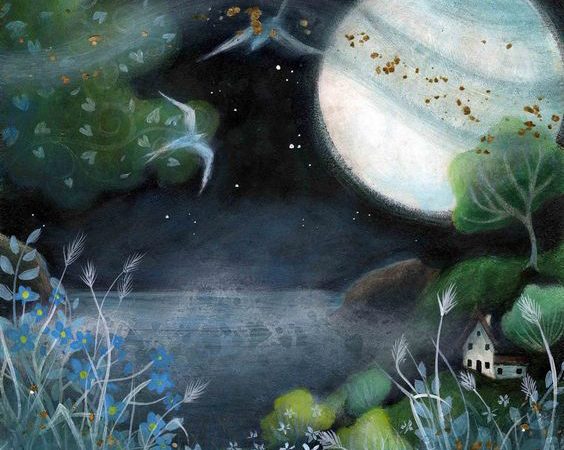Sea Mist and Moon by Amanda Clark
Approximately every 29 days, the moon goes around the earth. Sometimes we see it at night, but other times it’s visible during the day. Many women want to keep track of the moon’s cycle, once they understand how much the moon can help them understand their own menstrual cycle. But it can be tricky to watch the moon!
- How will you know where to find it?
- Will it be rising at sunset tonight?
- What about tomorrow night – when will it rise then?
- Why can’t you see the moon in the night sky some of the time?
- If you’d like to know know where to look for the moon from week to week, this review will help.
There are a few basic clues that will help you know where to look for the moon as it goes through its phases. The simplest thing to know is that New Moon is always next to the sun, and Full Moon is always opposite the sun, meaning Full Moon rises at sunset.
During the two weeks from New Moon until Full Moon, the moon will be in the sky right at sunset, and easy to see. After that, for the next two weeks, as it keeps rising later and later, it is in the night sky very late. It is also visible during the day a good part of the time. Now, let’s go through the phases week by week.
Let’s start with Dark Moon.
Dark Moon doesn’t get a lot of attention, because you can’t see it at all. When the moon is “dark,” it is so near the sun, from our perspective, that if we tried to see it, we’d be looking almost right at the sun. Dark moon sets when the sun sets and rises when the sun rises.
We could not see the part of the moon that the sun is shining on, anyway, since it is facing away from earth. As the moon moves away from the sun again, a little more each night, we are able to see the edge of the bright side; this lovely sliver in the evening sky is the New Moon.
The New Moon
New Moon sets soon after the sun sets. We see it briefly in the evening sky, after the sun has set. Soon, the moon sets also. It will then follow the sun around the sky, and rise soon after the sun rises. New Moon is in the sky during the day, but with the sun so close to the moon, we really can’t see it.
The First Quarter Moon
First Quarter Moon has moved farther away from the sun. Halfway, in fact, so that as the sun sets, the moon is straight overhead. It will be in the sky for the first half of the night before it also sets. It rises around noon, which brings it overhead by the time the sun sets. It is far enough from the sun now, that we can see it, if we know where to look.
The Full Moon
As Full Moon approaches, it has moved to the opposite side of the earth from the sun. So, Full Moon will always rise at sunset. Then, if you get up early enough the next morning, before sunrise, you can see the Full Moon setting as the sun rises! This is so beautiful, and such a surprise if you’re not expecting it.***
The Waning Quarter Moon
After Full Moon, as the moon moves back toward the other side of the earth, there will be another Quarter Moon. This waning Quarter Moon will rise very late and be in the sky for the last half of the night. It will be directly overhead when the sun rises, so it will be in the daytime sky in the morning hours.
If you remember to put the moonrise on your calendar on Full Moon nights, you can watch it come up at sunset. Sometimes you can see the glow in the sky before it makes its appearance – other times it is a surprise! It is always magical to see it emerge above the horizon.
The moon rises approximately an hour later each night. ( Since the moon goes around the earth in 28 days, and there are 24 hours in a day, the moon’s position changes by a little less than an hour each day, on average. )
What this means in practical terms is that on the night after Full Moon, you will have to wait an hour after sunset before you can see the moonrise! For this reason it’s fun to remember to watch it rise on the night before Full Moon, when you don’t have to wait so long. The sun will have not quite set when the moon rises, but the moon has a beautiful glow in the pale eastern sky on those evenings, as the sunlight fades.
You will learn where to look for the moon as you learn to remember what phase it’s in from one week to the next. Remember that for the two weeks between New Moon and Full Moon, it will be easy to find the moon in the evening sky around sunset.
It’s good to keep the moon’s “calendar” in mind, just as you keep the regular calendar in mind. Knowing what the moon is doing gives you a daily sense of its natural, predictable rhythm. Is the moon growing, or waning? Is full moon coming soon? Learning to watch the moon as often as possible can even help to regulate an irregular menstrual cycle! This is how closely and mysteriously we are linked to its rhythm, as it resonates within us.
***These aspects are approximate. If the moon is EXACTLY between the earth and the sun, (Dark Moon) there is a solar eclipse, which happens a couple of times a year. The moon moves between us and the sun, causing the sun to darken. This can be seen better from certain parts of the earth which happen to be exactly in alignment with the sun and moon during that particular eclipse.
When the moon is on the far side of the earth from the sun, (Full Moon) and it is EXACTLY opposite the sun, the earth’s shadow falls right onto the moon, and there is a lunar eclipse. The moon goes dark. This also happens a couple of times a year.


